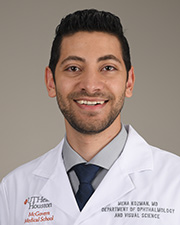Fire Risk of Supplemental Oxygen Use During Ophthalmic Surgery: An ARVO 2024 Resident Presentation
Fire Risk of Supplemental Oxygen Use During Ophthalmic Surgery: An ARVO 2024 Resident Presentation
 The Knights Templar Eye Foundation awarded one of our new residents, Mena Kozman, MD, a travel grant to present a poster at the 2024 Association for Research in Vision and Ophthalmology (ARVO) meeting in Seattle. Dr. Kozman began his presentation with alarming facts: More than 650 surgical fires occur annually in the United States, with 90% of the cases involving electrocautery and 95% of the cases involving open-system delivery of oxygen, such as via nasal cannula.
The Knights Templar Eye Foundation awarded one of our new residents, Mena Kozman, MD, a travel grant to present a poster at the 2024 Association for Research in Vision and Ophthalmology (ARVO) meeting in Seattle. Dr. Kozman began his presentation with alarming facts: More than 650 surgical fires occur annually in the United States, with 90% of the cases involving electrocautery and 95% of the cases involving open-system delivery of oxygen, such as via nasal cannula.
“Despite the standard guidelines, which recommend oxygen supplementation of 30% or less to reduce such fire risks,” Dr. Kozman explained, “100% oxygen is frequently given via nasal cannula, and little is known regarding the true periocular oxygen concentration.”
Conducting a study involving an adult volunteer and a manikin head to simulate typical operative settings, Dr. Kozman discussed the differences in periocular oxygen levels seen at different flow rates and with various draping methods such as towel drapes, eye drapes, and no drapes.
The results showed that periocular oxygen concentrations were frequently above 30%, highlighting the operative fire risk when open-system delivery of oxygen is used. The use of draping posed significantly greater risks compared to no drapes. Lastly, pausing oxygen supplementation for at least 40 seconds was essential to minimizing the operative fire risk.
Drs. Timothy McCulley and Ying Chen served as mentors for this project.